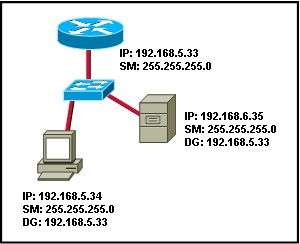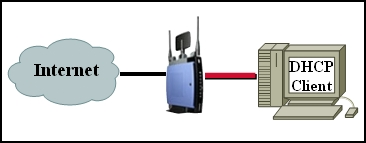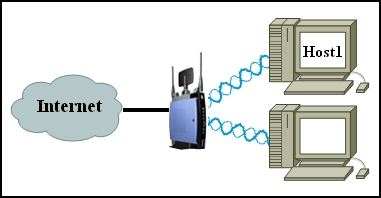CCNA 1 Chapter 5

These quiz is prepared to take for whom want to measure the knowledge and ability only. This is not the only way to cheat other but it can improve your knowledge base on what you have learn.
- 1.
How large are IPv4 addresses?
- A.
8 bits
- B.
16 bits
- C.
32 bits
- D.
64 bits
- E.
128 bits
Correct Answer
C. 32 bitsExplanation
IPv4 addresses are 32 bits in size. This means that they are composed of 32 binary digits, which can be represented as a series of four numbers separated by periods. Each number can range from 0 to 255, resulting in a total of approximately 4.3 billion unique IPv4 addresses. However, due to the increasing number of devices connected to the internet, IPv4 addresses have become scarce, leading to the adoption of IPv6 addresses with a size of 128 bits.Rate this question:
-
- 2.
Refer to the graphic. A user at the workstation cannot connect to the server. All cables have been tested and are working and all devices have IP addressing. However, the user cannot ping the server. What is causing the problem?
- A.
The router interface does not have a default gateway.
- B.
The switch does not have an IP address and default gateway.
- C.
The workstation and server are on different logical networks.
- D.
The workstation does not know the MAC address of the switch.
Correct Answer
C. The workstation and server are on different logical networks.Explanation
The problem is caused by the workstation and server being on different logical networks. In order for devices to communicate with each other, they must be on the same network. Since the workstation and server are on different logical networks, they are unable to establish a connection, resulting in the inability to ping the server.Rate this question:
-
- 3.
Which part of an IP address identifies a specific device on a network?
- A.
First two octets
- B.
Third and fourth octets
- C.
Network portion
- D.
Host portion
- E.
Only the fourth octet
Correct Answer
D. Host portionExplanation
The host portion of an IP address identifies a specific device on a network. IP addresses are divided into two parts: the network portion and the host portion. The network portion identifies the network to which the device is connected, while the host portion identifies the specific device within that network. Therefore, the host portion is the part of the IP address that uniquely identifies a device on a network.Rate this question:
-
- 4.
Given a host with the IP address 172.32.65.13 and a default subnet mask, to which network does the host belong?
- A.
172.32.65.0
- B.
172.32.65.32
- C.
172.32.0.0
- D.
172.32.32.0
Correct Answer
C. 172.32.0.0Explanation
The given IP address 172.32.65.13 belongs to the network 172.32.0.0 because the default subnet mask is used. The default subnet mask for a Class B IP address is 255.255.0.0, which means the first two octets (172.32) represent the network portion, and the last two octets (65.13) represent the host portion. Therefore, the host belongs to the network 172.32.0.0.Rate this question:
-
- 5.
Which default subnet mask provides the most host bits?
- A.
255.0.0.0
- B.
255.255.0.0
- C.
255.255.255.0
- D.
255.255.255.252
Correct Answer
A. 255.0.0.0Explanation
The subnet mask 255.0.0.0 provides the most host bits because it has only the first octet (8 bits) reserved for the network portion, allowing for a larger number of possible host addresses. The remaining three octets (24 bits) can be used for host addresses, resulting in a larger number of available hosts compared to the other subnet masks listed.Rate this question:
-
- 6.
How many bits are available for Class B host IP addresses using a default subnet mask?
- A.
4
- B.
8
- C.
16
- D.
24
Correct Answer
C. 16Explanation
Class B host IP addresses use a default subnet mask of 16 bits. This means that the first 16 bits of the IP address are used to identify the network, while the remaining 16 bits are available for addressing individual hosts within that network.Rate this question:
-
- 7.
How many usable hosts are available given a Class C IP address with the default subnet mask?
- A.
254
- B.
255
- C.
256
- D.
510
- E.
511
Correct Answer
A. 254Explanation
A Class C IP address has a default subnet mask of 255.255.255.0, which means that the first three octets are reserved for the network address and the last octet is reserved for host addresses. In this case, the last octet can accommodate 256 possible values (0-255), but two of them are reserved for the network address (0) and the broadcast address (255), leaving 254 usable host addresses.Rate this question:
-
- 8.
Assuming a default mask, which portion of the IP address 175.124.35.4 represents the host?
- A.
175.124
- B.
35.4
- C.
.4
- D.
124.35.4
- E.
175.124.35
Correct Answer
B. 35.4Explanation
The portion of the IP address 175.124.35.4 that represents the host is 35.4. In an IP address, the host portion refers to the specific device or computer on a network. In this case, the first two numbers (175.124) represent the network, and the last two numbers (35.4) represent the host.Rate this question:
-
- 9.
Which of the following are private IP addresses? (Choose three.)
- A.
10.1.1.1
- B.
172.32.5.2
- C.
192.167.10.10
- D.
172.16.4.4
- E.
192.168.5.5
Correct Answer(s)
A. 10.1.1.1
D. 172.16.4.4
E. 192.168.5.5Explanation
The given IP addresses 10.1.1.1, 172.16.4.4, and 192.168.5.5 are private IP addresses. Private IP addresses are reserved for use within private networks and are not routable on the internet. These addresses are commonly used in home and office networks for internal communication. The IP addresses 172.32.5.2 and 192.167.10.10 are not private IP addresses as they fall outside the range of private IP address ranges.Rate this question:
-
- 10.
What destination IP address is used in a unicast packet?
- A.
A specific host
- B.
A group of host
- C.
The default gateway
- D.
The network broadcast address
Correct Answer
A. A specific hostExplanation
In a unicast packet, the destination IP address is used to specify a specific host. Unicast communication is a one-to-one transmission where a packet is sent from a single source to a single destination. The destination IP address in the packet header is the unique identifier of the intended recipient host.Rate this question:
-
- 11.
What is the destination MAC address in a multicast Ethernet frame?
- A.
The MAC address of the sending host
- B.
The MAC address of the destination hos
- C.
An address that begins with 01-00-5E in hexadecimal
- D.
A 48-bit hexadecimal address expressed as FF-FF-FF-FF-FF-FF
Correct Answer
C. An address that begins with 01-00-5E in hexadecimalExplanation
The destination MAC address in a multicast Ethernet frame is an address that begins with 01-00-5E in hexadecimal. Multicast addresses are used to send data to a group of devices rather than a single destination. The first 6 bits of a multicast MAC address are always set to 01-00-5E, followed by 23 bits that represent the multicast group address. This allows the frame to be received by all devices that are part of the multicast group.Rate this question:
-
- 12.
Yvonne is talking to her friend on the phone. What type of message is this?
- A.
Broadcast
- B.
Simulcast
- C.
Multicast
- D.
Unicast
Correct Answer
D. UnicastExplanation
This type of message is referred to as "unicast" because Yvonne is having a one-to-one conversation with her friend on the phone. Unicast is a communication method where a message is sent from one sender to one specific receiver.Rate this question:
-
- 13.
What information must be included within a unicast message for it to be delivered on an Ethernet network?
- A.
MAC and IP addresses for the default router
- B.
IP address and subnet mask of the default gateway
- C.
MAC and IP addresses that correspond to a destination grou
- D.
MAC and IP addresses that correspond to a specific destination host
Correct Answer
D. MAC and IP addresses that correspond to a specific destination hostExplanation
In order for a unicast message to be delivered on an Ethernet network, the MAC and IP addresses that correspond to a specific destination host must be included. This is because Ethernet networks use MAC addresses to identify and deliver messages to specific devices on the network, while IP addresses are used for routing the message to the correct destination host. Including both the MAC and IP addresses ensures that the message is properly addressed and delivered to the intended recipient.Rate this question:
-
- 14.
A PC obtains its IP address from a DHCP server. If the PC is taken off the network for repair, what happens to the IP address configuration?
- A.
The configuration is permanent and nothing changes.
- B.
The address lease is automatically renewed until the PC is returned.
- C.
The address is returned to the pool for reuse when the lease expires.
- D.
The configuration is held by the server to be reissued when the PC is returned.
Correct Answer
C. The address is returned to the pool for reuse when the lease expires.Explanation
When a PC is taken off the network for repair, its IP address configuration is not permanent. The PC obtains its IP address from a DHCP server, and the address is leased to the PC for a specific period of time. When the lease expires, the IP address is returned to the pool of available addresses for reuse by other devices. Therefore, when the PC is returned from repair, it will need to obtain a new IP address from the DHCP server.Rate this question:
-
- 15.
Which type of server dynamically assigns an IP address to a host?
- A.
ARP
- B.
DHCP
- C.
DNS
- D.
RARP
Correct Answer
B. DHCPExplanation
DHCP stands for Dynamic Host Configuration Protocol. It is a network protocol that allows a server to automatically assign an IP address to a host. This eliminates the need for manual configuration of IP addresses, making it easier to manage and maintain a network. DHCP dynamically assigns IP addresses from a pool of available addresses, ensuring that each host on the network has a unique address. Therefore, DHCP is the correct answer for the type of server that dynamically assigns an IP address to a host.Rate this question:
-
- 16.
Which three statements describe a DHCP Discover message? (Choose three.)
- A.
The source MAC address is 48 ones (FF-FF-FF-FF-FF-FF).
- B.
The destination IP address is 255.255.255.255.
- C.
The message comes from a server offering an IP address.
- D.
The message comes from a client seeking an IP address.
- E.
All hosts receive the message, but only a DHCP server replies.
Correct Answer(s)
B. The destination IP address is 255.255.255.255.
D. The message comes from a client seeking an IP address.
E. All hosts receive the message, but only a DHCP server replies.Explanation
A DHCP Discover message is sent by a client seeking an IP address. The destination IP address for this message is 255.255.255.255, which is a broadcast address, allowing all hosts on the network to receive the message. However, only a DHCP server can reply to this message.Rate this question:
-
- 17.
Refer to the graphic. A host connects to a Linksys integrated router that is also a DHCP server and receives an IP address from it. Which address does the host need to access the ISP and the Internet?
- A.
IP address of the destination host
- B.
Public gateway IP address of the ISP
- C.
External IP address of the integrated router that connects to the ISP
- D.
Internal IP address of the integrated router that connects to the local network
Correct Answer
D. Internal IP address of the integrated router that connects to the local networkExplanation
The host needs to access the ISP and the Internet through the internal IP address of the integrated router that connects to the local network. This is because the router acts as a gateway between the local network and the ISP, and the host must communicate with the router to access the external network. The internal IP address is used for communication within the local network, while the external IP address is used for communication with the ISP and the Internet.Rate this question:
-
- 18.
Which statement is true concerning private IP addresses?
- A.
Ensures that two networks separated by the Internet use unique IP network numbers
- B.
Allows internal hosts to communicate with servers across the Internet
- C.
Solves the issue of a finite number of available public IP addresses
- D.
Allows for ISPs to be able to quickly determine network location
Correct Answer
C. Solves the issue of a finite number of available public IP addressesExplanation
Private IP addresses solve the issue of a finite number of available public IP addresses. This is because private IP addresses are used within a local network and are not directly accessible from the internet. By using private IP addresses, organizations can conserve the limited pool of public IP addresses and allow multiple devices to share a single public IP address when accessing the internet.Rate this question:
-
- 19.
What is one of the purposes of NAT?
- A.
Filters network traffic based on IP address ranges
- B.
Prevents external users from detecting the IP addresses used on a network
- C.
Inspects traffic that might be harmful or used in an attack against the network
- D.
Translates IP addresses into easy-to-remember domain names
Correct Answer
B. Prevents external users from detecting the IP addresses used on a networkExplanation
NAT, or Network Address Translation, is a technique used to translate private IP addresses to public IP addresses and vice versa. One of the purposes of NAT is to prevent external users from detecting the IP addresses used on a network. By hiding the internal IP addresses behind a single public IP address, NAT adds a layer of security by making it difficult for external users to directly access or identify the devices on the network. This helps protect against potential attacks or unauthorized access attempts.Rate this question:
-
- 20.
Which two statements describe packets that are sent through a Linksys integrated router using NAT? (Choose two.)
- A.
Packets that are sent to any destination need to be translated.
- B.
Packets that are sent to hosts on the same network need to be translated.
- C.
Packets that are sent to a destination outside the local network need to be translated.
- D.
Packets that are sent to a destination outside a local network do not need to be translated.
- E.
Packets that are sent between hosts on the same local network do not need to be translated.
Correct Answer(s)
C. Packets that are sent to a destination outside the local network need to be translated.
E. Packets that are sent between hosts on the same local network do not need to be translated.Explanation
Packets that are sent through a Linksys integrated router using NAT need to be translated when they are sent to a destination outside the local network. This is because NAT (Network Address Translation) is used to translate private IP addresses to public IP addresses, allowing the packets to be properly routed on the internet. However, packets that are sent between hosts on the same local network do not need to be translated, as they are already on the same network and can communicate using their private IP addresses.Rate this question:
-
- 21.
Refer to the graphic. NAT and DHCP are installed on the Linksys integrated router. Which IP address is most likely to be assigned to the local computer, Host1?
- A.
10.0.0.17
- B.
128.107.1.2
- C.
192.135.250.0
- D.
209.165.201.1
Correct Answer
A. 10.0.0.17Explanation
The most likely IP address to be assigned to the local computer, Host1, is 10.0.0.17. This is because NAT (Network Address Translation) and DHCP (Dynamic Host Configuration Protocol) are installed on the Linksys integrated router. NAT allows multiple devices on a local network to share a single public IP address, and DHCP is responsible for assigning IP addresses to devices on the network. The IP address 10.0.0.17 is within the range of private IP addresses typically used by routers for local network devices.Rate this question:
-
Quiz Review Timeline +
Our quizzes are rigorously reviewed, monitored and continuously updated by our expert board to maintain accuracy, relevance, and timeliness.
-
Current Version
-
Mar 20, 2023Quiz Edited by
ProProfs Editorial Team -
Apr 20, 2010Quiz Created by
Lytayquize
 Back to top
Back to top




